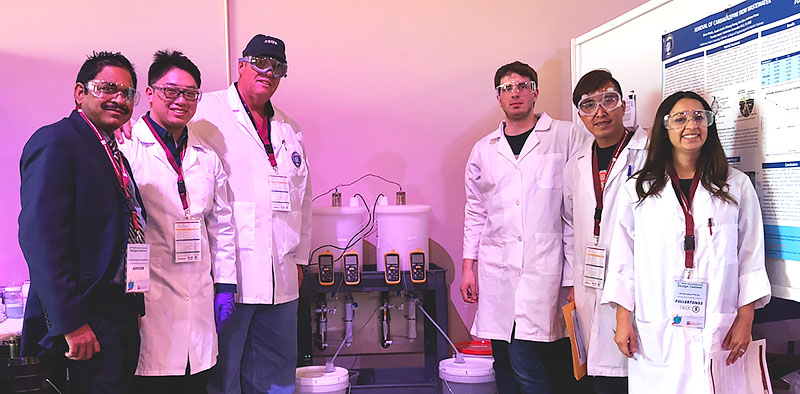
A team of engineering students is focusing on solving an environmental public health issue by developing a wastewater treatment system that removes residual pharmaceutical drugs found in the water supply.
The undergraduates are working under faculty adviser Sudarshan Kurwadkar to design and build a system that would remove carbamazepine, a commonly prescribed drug used to control epilepsy and seizures, and to treat bipolar and nerve disorders.
“This drug is routinely detected in wastewater, and since it is a bioactive compound, it could pose a serious ecological risk to aquatic microorganisms,” said student Brian Motts, the project’s team lead. “It’s imperative to remove this compound from wastewater before it reaches other water bodies.”
The annual consumption of carbamazepine in the United States is about 50 tons per year, said Kurwadkar, associate professor of civil and environmental engineering.
“Once administered, nearly 9 percent of this drug is released through urine to the environment,” Kurwadkar added. “Consequently, carbamazepine has been routinely detected in wastewater, surface water and groundwater.”
Advanced technologies have been tested for removal of carbamazepine, Kurwadkar continued, but none have proved a universal solution.
“It’s been a great opportunity to work with Dr. Kurwadkar because he is helping me to understand how theoretical knowledge is applied to practical models.” — Khuong Truong
The faculty-student research project is a hybrid treatment system that includes a pump-based, continuous-flow photocatalytic reactor design that utilizes twin strategies for effective removal of carbamazepine from water sources.
In the first phase, water that contains carbamazepine passes through a reactor, which has an ultraviolet light source to destroy the drug, Kurwadkar explained. In the second phase, water passes through a granulated-activated carbon material that absorbs any remaining carbamazepine.
“The bench-scale module that was developed can be used at the community level for removal of drugs from wastewater, which would help maintain clean water resources and minimize adverse environmental impacts,” said Motts, an electrical engineering major.
Motts, who works as a research engineer, laid the groundwork for the project in spring 2017. This past academic year, students Ben Chan, Austin Emrich, Andreana Romero and Khuong Truong, all civil engineering majors, joined the project.
“It’s been a great opportunity to work with Dr. Kurwadkar because he is helping me to understand how theoretical knowledge is applied to practical models,” said Truong, who graduates next year.
This spring Truong presented the project and won an Outstanding Student Award, given in memory of Intel’s Terry McManus, at the WERC Environmental Design Contest at New Mexico State University. The multidisciplinary project, which involves environmental, mechanical and electrical engineering principles, as well as optical physics and chemistry, also won the 2018 Most Innovative Award at the College of Engineering and Computer Science’s annual spring student project showcase.
“By working with other senior students, I’ve not only improved my time-management skills, but also how to work well others, which will help me to get a good job in environmental engineering,” Truong added.
Motts also noted that the project gives students real-world, hands-on experience and the opportunity to collaboratively explore and discover the STEM disciplines to “reimagine engineering.”
“Research projects help students to develop personal and interpersonal skills, and challenge us to learn on our own,” he said.
The researchers are continuing to test the system for removal of other pharmaceutical compounds, Kurwadkar said.
“There is a potential that the idea can be commercialized,” Kurwadkar added. “But since this is a bench-scale version, long-term studies and funding are required to fine-tune the project.”